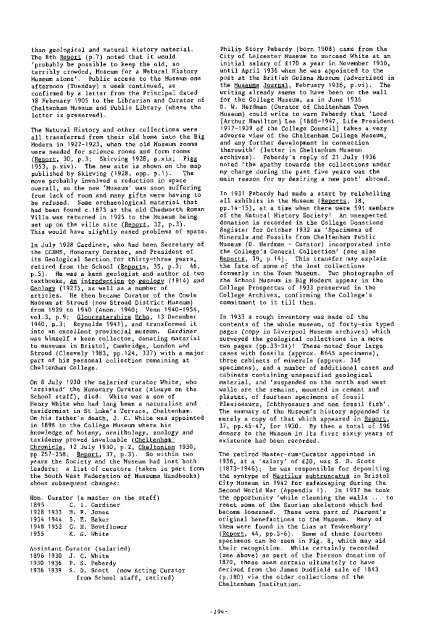Number 5 - Geological Curators Group
Number 5 - Geological Curators Group
Number 5 - Geological Curators Group
You also want an ePaper? Increase the reach of your titles
YUMPU automatically turns print PDFs into web optimized ePapers that Google loves.
than geological and natural history material.The 8th M (p.7) noted that it would'probably be possible to keep the old, soterribly crowded, Museum for a Natural HistoryMuseum alone'. Public access to the Museum oneafternoon (Tuesday) a week continued, asconfirmed by a letter from the Principal dated18 February 1905 to the Librarian and Curator ofCheltenham Museum and Public Library (where theletter is preserved).The Natural History and other collections wereall transferred from their old home into the BigModern in 1922-1923, when the old Museum roomswere needed for science rooms and form rooms(m, 30, p.3; Skirving 1928, p.xix; Pigg1953, p.xiv). The new site is shown on the mapPublished by Skirving (1928, opp. p.1). Themove probably involved a reduction in spaceoverall, so the new 'Museum' was soon sufferingfrom lack of room and many gifts were having tobe refused. Some archaeological material thathad been found c.1875 at the old Chedworth RomanVilla was returned in 1925 to the Museum beingset up on the villa site (M, 32, p.3).This would have slightly eased problems of space.In July 1928 Gardiner, who had been Secretary ofthe CCNHS, Honorary Curator, and President ofits <strong>Geological</strong> Section for thirty-three years,retired from the School (m, 35, p.3; 46,p.5). He was a keen geologist and author of twotextbooks, An introduction to eeala~ (1914) and(1923), as well as a number ofarticles. He then became Curator of the CowleMuseum at Stroud (now Stroud District Museum)from 1929 to 1940 (Anon. 1940; Venn 1940-1954,"01.3, p.9: Gloucestershire Echo, 13 December1940, p.3; Reynalds 1941), and transformed itinto an excellent provincial museum. Gardinerwas himself a keen collector, donating materialto museums in Bristol, Cambridge, London andStraud (Cleevely 1983, pp.124, 337) with a majorpart of his personal collection remaining atCheltenham College.On 8 July 1930 the salaried curator White, who'assisted' the Honorary Curator (always on theSchool staff), died. White was a son ofHenry White who had long been a naturalist andtaxidermist in St Luke's Terrace, Cheltenham.On his father's death, J. C. White was appointedin 1896 to the College Museum where hisknowledge of botany, ornithology, zoology andtaxidermy proved invaluable (CheltenhamChronicle, 12 July 1930, p.2, Cheltanian 1930,pp.257-258; M, 37, p.3). So within twoyears the Society and the Museum had lost bothleaders; a list of curators (taken in part fromthe South West Federation of Museums Handbooks)shows subsequent changes:Hon. Curator fa master on the staff)1895 C. I. Gardiner1928 1933 H. F. Jones1934 1944 S. E. Baker1948 1952 C. H. Boutflower1955 K. G. WhiteAssistant Curator (salaried)1896 1930 J. C. White1930 1936 P. S. Peherdv21936 1939 S. D. Scatt (now Acting Curatarfrom School staff, retired)Philip Story Peberdy (born 1908) came from theCity of Leicester Museum to succeed White at aninitial salary of E170 a year in November 1930,until April 1936 when he was appointed to thepost at the British Guiana Museum (advertised inthe Museums Journal, February 1936, p.vi). Thewriting already seems to have been on the wallfor the College Museum, as in June 1936D. W. Herdman (Curator of Cheltenham TownMuseum) could write to warn Peberdy that 'Lord[Arthur Hamilton] Lee [1868-1947, Life President1917-1939 of the College Council] takes a veryadverse view of the Cheltenham College Museum,and any further development in connectiontherewith' (letter in Cheltenham Museumarchives). Peberdy's reply of 21 July 1936noted 'the apathy towards the collections undermy charge during the past five years was themain reason for my desiring a new post' abroad.In 1931 Peberdy had made a start by relabellingall exhibits in the Museum (-, 38,pp.14-IS), at a time when there were 591 membersof the Natural History Society! An unexpecteddonation is recorded in the College DonationsRegister for October 1932 as 'Specimens ofMinerals and Fossils from Cheltenham PublicMuseum (D. Herdman - Curator) incorporated intothe College's General Collection' (see alsoMeports, 39, p.14). This transfer may explainthe fate of some of the lost collectionsformerly in the Town Museum. Two photographs ofthe School Museum in Big Modern appear in theCollege Prospectus of 1933 preserved in theCollege Archives, confirming the College'scommitment to it till then.In 1933 a rough inventory was made of thecontents of the whole museum, of forty-six typedpages (copy in Liverpool Museum archives) whichsurveyed the geological collections in a meretwo pages (pp.33-34)! These noted four largecases with fossils (approx. 8645 specimens),three cabinets of minerals (approx. 348specimens), and a number of additional cases andcabinets containing unspecified geologicalmaterial, and 'suspended on the north and westwalls are the remains, mounted in cement andplaster, of fourteen specimens of fossilPlesiosaurs, Ichthyosaurs and one fossil fish'.The summary of the Museum's history appended ismerely a copy of that which appeared in m,37, pp.45-47, for 1930. By then a total of 596donors to the Museum in its first sixty years ofexistence had been recorded.The retired Master-cum-Curator appointed in1936, at a 'salary' of f20, was S. D. Scott(1873-1946); he was responsible for depositingthe syntypeof Nautilus iubtruncatus in-BristoiCity Museum in 1942 for safekeeping during theSecond World War (Appendix l).In 1937 he tookthe opportunity 'ihiie cleaning the walls . . . toreset some of the Saurian skeletons which hadbecome loosened. These were part of Pierson'soriginal benefactions to the Museum. Many ofthem were found in the Lias at Tewkesbury'(M, 44, pp.5-6). Some of these fourteenspecimens can be seen in Fig. 8, which may aidtheir recognition. While certainly recorded(see above) as part of the Pierson donation of1870, these seem certain ultimately to havederived from the James Dudfield sale of 1843(p.180) via the older collections of theCheltenham Institution.
















